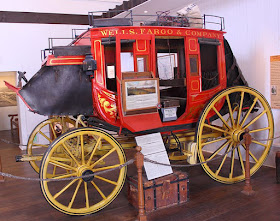Those stylish, elegant coaches of yesteryear are so
nostalgic, romantic, cozy and quaint. Or perhaps it’s our imagination that
makes them so appealing.
A couple of weeks ago, my husband and I decided to go ‘up
north’ to check on our property. It’s about 300 miles, and we thought little
about traveling that far and back in a couple of days. It takes about six hours
to get there, including stopping to eat, etc. However, for the characters in my books, it
would have been a much more extensive journey. Back then, trains mainly
traveled east and west, therefore, any north/south travel was completed by
stage. Depending upon how often they stopped, the weather and terrain, stage
coaches took between 8-14 hours to travel fifty miles.
The term Stagecoach came about because of the ‘coaches’ that
carried passengers along a route in ‘stages’. Stagecoaches could be anything
from buckboard wagons to elaborate ‘coaches.’ As long as they were used for
public transportation and ran a regularly scheduled route, they were considered
stagecoaches. Depending on the route, the number of regular passengers, the
weather, and the distance, the coaches would vary, as would the number of
horses or mules. Four was the usual number, but six-team coaches were not
uncommon, especially for the larger, ‘overland’ stages, and the smaller, shorter
coaches and routes were usually pulled by two horses. The average speed was
five to twelve miles and hour.
Despite close quarters, long, bumpy and dusty roads, and
threats of Indian or outlaw attacks, stagecoaches flourished and were widely
used, even after the railroads crossed the nation. The term stationwagon came about when long
wagons boasting three wide bench seats came into service for the specific role
of carrying passengers to and from railroad stations.
In most vehicles, passengers were provided an average of 15
inches each, and sat with their knees dovetailed with the traveler across from
them, and depending on other cargo the stage was carrying, passengers often had
to hold their luggage on their laps. Etiquette, and/or, passenger behavior was
strictly enforced. Wells Fargo had this list of rules posted:
· Abstinence from liquor is requested, but if
you must drink share the bottle. To do otherwise makes you appear selfish and
unneighborly.
· If ladies are present, gentlemen are urged to
forego smoking cigars and pipes as the odor of same is repugnant to the gentler
sex. Chewing tobacco is permitted, but spit with the wind, not against it.
· Gentlemen must refrain from the use of rough
language in the presence of ladies and children.
· Buffalo robes are provided for your comfort
in cold weather. Hogging robes will not be tolerated and the offender will be
made to ride with the driver.
· Don't snore loudly while sleeping or use your
fellow passenger's shoulder for a pillow; he or she may not understand and
friction may result.
· Firearms may be kept on your person for use
in emergencies. Do not fire them for pleasure or shoot at wild animals as the
sound riles the horses.
· In the event of runaway horses remain calm.
Leaping from the coach in panic will leave you injured, at the mercy of the
elements, hostile Indians and hungry coyotes.
· Forbidden topics of conversation are:
stagecoach robberies and Indian uprisings.
· Gents guilty of unchivalrous behavior toward
lady passengers will be put off the stage. It's a long walk back. A word to the
wise is sufficient.
Fares varied, not only due to distance, but class as well.
First class meant you rode all the way.
Second class meant you had to walk at bad places along the
road.
Third class meant you had to push the coach when needed,
especially on hilly terrain.
Depending on the schedule, some stagecoaches would travel
all night, stopping only for fresh horses and quick meals. When an overnight
stay was included, the coach often arrived around midnight, and left again by
six the following morning. Passengers were encouraged to pack food provisions
and they were also told not to grease their hair before traveling because dust
would stick to it.
Stagecoaches came to an end around 1915, when motor buses
took the place of the horse-drawn coaches.
I’ve ridden in a few ‘tourist’ stagecoaches, and the short
rides were fun, but I must admit I prefer modern transportation options. In the
story I’m writing right now, the heroine travels over 300 miles via stage from
Texas to Kansas with her three-year-old niece. The journey took a week for them
to complete.
That story won’t be released until 2018, but my 30th
book with Harlequin was released April 1st.
Long ago, orphans Bridgette Banks and Garth McCain made a promise to stay together. But it's been years since they were parted, and Bridgette's almost given up hope! So when Garth's cattle trail passes her town, she won't let him leave her behind again…
Sparks fly as they're reunited—especially when the cowboy catches Bridgette telling everyone she's his bride! Faced with a past he thought he'd lost forever, Garth realizes this impulsive beauty might be the future he never thought he deserved.




What a great article. Wow congratulations on 30 books published and good luck on the new one. Thank you for sharing the information you have sought-out for your wonderful stories.
ReplyDeleteThank you!
ReplyDelete